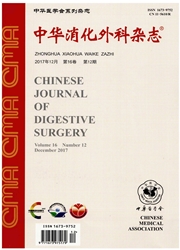

 中文摘要:
中文摘要:
目的观察组织转谷氨酰胺酶(tTG)特异性抑制剂六甲烯胺对四氯化碳(CCl4)诱导的大鼠肝纤维化形成的影响。方法雄性SD大鼠100只,按随机数字表法分成正常对照组(20只)、肝纤维化组(40只)、六甲烯胺组(40只)。用腹腔内注射CCl4诱导大鼠肝纤维化模型,在注射CCl4的前2d开始腹腔内注射六甲烯胺(112mg·kg^-1·d^-1),直到注射CCl4的第4、8周处死大鼠,摘取肝脏并提取血清,应用RT—PCR检测tTG、α-平滑肌抗体(α-SMA)、Ⅰ型胶原蛋白和基质金属蛋白酶抑制剂-1(TIMP-1)等基因的mRNA表达情况,应用Western blot检测tTG和α-SMA蛋白的表达,肝功能和肝脏组织中羟脯氨酸的含量,同时取大鼠肝脏行组织学检查,并对肝纤维化程度进行半定量计分系统分级评分。采用单因素方差分析检测结果。结果CCl4注射8周后,肝纤维化组肝损伤明显,ALT、总胆汁酸、TBil、羟脯氨酸、tTG、α-SMA、Ⅰ型胶原蛋白酶、TIMP-1分别为(1313±157)U/L、(99.9±18.5)μmol/L、(10.9±1.6)μmol/L、(55±12)μg/g、145.6±51.2、130.3±44.6、211.3±75.1、162.4±53.5;而六甲烯胺处理后,肝纤维化程度、肝功能指标均显著降低,ALT、总胆汁酸、TBil、羟脯氨酸、tTG、α—SMA、Ⅰ型胶原蛋白酶、TIMP-1分别为(378±87)U/L、(61.0±12.7)μmoL/L、(9.8±1.7)μmol/L、(70±14)μg/g、48.6±12.3、40.7±12.3、63.9±16.0、59.2±23.4。结论六甲烯胺能通过抑制tTG途径显著改善CCl4诱导的大鼠肝纤维化程度。
 英文摘要:
英文摘要:
Objective To observe the effects of cystamine, a tissue transglutaminase (tTG) inhibitor, on the development of rat liver fibrosis induced by carbon tetrachloride. Methods One hundred male SD rats were randomly divided into control group (n = 20), hepatic fibrosis group (n = 40) and cystamine group (n = 40) . Liver fibrosis model was induced by intraperitoneal injection of carbon tetrachloride. Cystamine (112 mg· kg^-1 · d^-1) was administered by intraperitoneal injection 2 days before injection of carbon tetraehloride. The rats were sacrificed at weeks 4 and 8, and the liver tissues and serum specimens were obtained. The mRNA expression of tTG, smooth muscle-alpha (α-SMA) , collagen-Ⅰ and tissue inhibitors of metalloproteinase-1 (TIMP-1) were detected by real time PCR. The protein expression of tTG and α-SMA, liver function and content of hydroxyproline in liver tissues were determined by Western blot. Histological changes of the liver was observed under microscope. The fibrosis conditions of rat liver in each group were evaluated according to the semi-quantitative scoring system. All the data were analyzed by one-way ANOVA. Results Eight weeks after the injection of carbon tetrachloride, obvious injury of the liver in liver fibrosis group was observed. The levels of alanine transaminase (ALT), total bile acid, total bilirubin, hydroxyproline, tTG, α-SMA, collagen-Ⅰ and TIMP-1 were (1313±157)U/L, (99.9±18.5)μmol/L, (10.9±1.6)μmol/L, (55±12)μg/g, 145.6±51.2, 130.3± 44.6, 211.3 ± 75.1 and 162.4 ± 53.5. After administration of eystamine, the levels of ALT, total bile acid, total bilirubin, hydroxyproline, tTG, α-SMA, collagen-Ⅰ and TIMP-1 were (378 ± 87) U/L, (61.0 ± 12.7) μmol/L, (9.8 ± 1.7) μ/L, (70 ± 14) μg/g, 48.6 ± 12.3, 40.7 ± 12.3, 63.9 ± 16.0, 59.2 ± 23.4. Conclusion Cystamine can alleviate the carbon tetrachloride-induced rat liver fibrosis by inhibiting the tTG pathway.
 同期刊论文项目
同期刊论文项目
 同项目期刊论文
同项目期刊论文
 期刊信息
期刊信息
